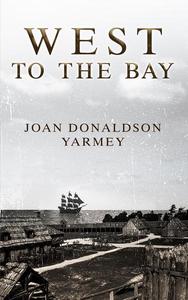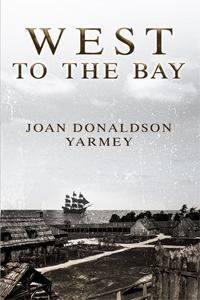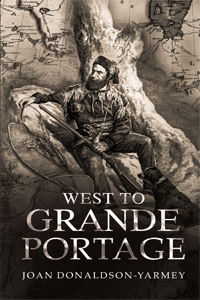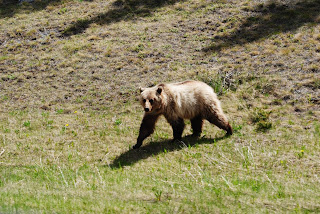https://www.bookswelove.com/donaldson-yarmey-joan/
https://books2read.com/Romancing-the-Klondike

https://books2read.com/Rushing-the-Klondike
My husband and I
hiked the trail in 1997, on the hundredth anniversary of the Klondike Gold Rush.
We were in the Yukon and Alaska so I could research the state and territory for
my travel book Backroads of Alaska and
the Yukon. That hike and my two trips to Dawson City were what made it
possible for me to write Romancing the
Klondike, book three of the Canadian Historical Brides Collection. The
sequel, Rushing the Klondike, is out
this month.
Many of the men and women who went to the
Klondike in the first year starved and froze because they hadn't brought along
enough supplies. To combat that, the North West Mounted Police decreed that the
prospectors had to have 907 kg (2000 lbs) of
provisions in order to cross the border from Alaska into British
Columbia and then onto the Yukon. The NWMP set up a scale to weigh each
person's supplies before letting them climb the Chilkoot Pass.
My husband and I each carried about 16kg
(35 lbs) on our five day hike up to and over the pass. Besides our food, we
carried a tent, sleeping bags, two changes of clothes, an extra pair of shoes in
case the pair we were wearing got wet or to change into in camp to give our
hiking shoes a breather.
The Chilkoot Trail was called the `poor‑man's
route'. It ran from Dyea to Bennett Lake following an old, first nations path. The
men and women who travelled to the Klondike in hopes of getting rich had to
haul their supplies up and over the summit. Some were able to hire indigenous
peoples to help but many had to do it themselves. They would carry as much as 36kg
(80 lbs) up the `Golden Stairs' (steps cut into the solid snow of the pass)
each trip, then slide back down to their cache and begin again. Most made 40
trips to do so. Once a miner got onto the steps he didn't dare get off until
the top. If fatigue forced him to step out he seldom managed to make it back
on.
Most of the people who started for the
Klondike were Cheechakos, a native word for `greenhorn'. It was after a person
had spent a winter in the north that he or she became known as a Sourdough.
The 53 kilometre (33 mile) long Chilkoot
Trail is called the `Longest Museum in the World'. There are 10 campsites along
it so we had plenty to choose from. We wanted to make sure our daily hikes
weren’t very long.
The trail started out with the Taiya River
to our left. We were continually climbing and descending beside it through a
rainforest whose tall trees created a nice, cool shade. We had to watch for
tree roots, stumps, and rocks and in places there was a drop-off so we made
sure our packs were secure and didn't wobble. We crossed a number of bridges,
made of metal, split logs, planks or boardwalks.
At kilometer 8 (mile 5) we reached
Finnegan's Point, the first campground on the trail. This was named after Pat
Finnegan and his two sons who set up a ferry service here in 1897. Later they
built a road through the damp, boggy areas and charged a toll. This worked only
in the summer because the prospectors pulled their goods on sleds on the frozen
ice in the winter. This point was also used as a cache where the stampeders
left their first bundles of supplies while they went back to Dyea for the rest.
4.8 kilometres (3 miles) from Finnegan's
Point we reached Canyon City campsite our first stop. We set up our tent then cooked
our supper. Once we had washed our dishes, we drained the water down the
screened-in pipe for gray water and scrapped the small food particles off the
screen into our garbage. This we hauled out with us. At the time we had to
hoist our food and garbage up on the bear pole to keep it from attracting bears
into the camp. We also made sure not to keep any food with us in our tent.
To reach the actual site of Canyon City, we
continued down the trail 0.8 kilometre (0.5 mile) past the camp until we reached
a sign with the distances to places: Canyon City Shelter 0.5 mile; Dyea 8
miles: Sheep Camp Shelter 5 miles; Chilkoot Pass 8.5 miles.
We followed the path to the left, crossed
over the suspension bridge and came to a sign that stated: Canyon City
Historical Site. We were now walking where Canyon City stood over 100 years
ago. We passed an old, rusted, cook stove and come to a huge, rusted boiler.
This 50 horsepower steam boiler was used to operate an aerial tramway between
here and the Chilkoot Pass. It cost 16.5 cents per kilogram (7.5 cents per
pound) to send goods over this tram. Few of the Klondikers could afford it.
Stamped on the boiler was: Union Iron
Works SF 1886.
The next morning we headed to Pleasant
Camp which was 4.5 kilometres (2.7 miles) from Canyon City. The climb out of
the canyon between the two camps was thought to be the worst part of the trail
by some stampeders. A little ways past the Pleasant Camp we crossed a suspension
bridge over a series of cascades. And in 2 kilometres (1.2 miles) we arrived at
Sheep Camp beside the Taiya River. This camp is the last stop before the
Chilkoot Pass and a ranger gave a talk about the conditions of the pass at
7:00pm Alaska time. Other words of advice were to leave by at least 7am, drink
2 litres of water on the trail and expect to take 10 hours to reach Happy Camp.
When we left Sheep Camp the next morning
the ground was level for the first bit and we came across a building that
looked almost like a train station. After we began climbing there was an old
log building with glass windows, little patio, and cooking utensils hanging on
the wall. We were climbing mainly on a path but sometimes over boulders and we left
the trees and were in alpine meadows.
The bears like to use the trail so we had
to be on the lookout for them, since they own the trail. It’s best if one gets
far off into the trees and let them have the right of way.
It was a 6.8 kilometre (4.2 mile) climb to
the Scales. This is where the prospectors who had hired professional indigenous
packers had to reweigh their goods. The packers wanted more money, up to $2.20
per kilogram (1 dollar per pound) to carry the supplies up and over the pass.
Consequently, many items were left behind and some still can be seen.
From the Scales we could see the Chilkoot
Pass and we crossed alpine tundra to reach the base. Past the Chilkoot is
Peterson Pass, a longer but easier alternative to the Chilkoot which was used
by some Klondikers.
Those who travelled the trail in the
winter climbed the 'Golden Stairs' cut in the ice and snow up the side of the
pass. Those who came in the summer, when the snow was melted, had to traverse
over the huge boulders and loose rock left from a slide. That was what we climbed
on.
The climb was steep and we had to lean
forward as we went from solid rock to solid rock. If we straightened up the
weight of our pack threatened to pull us over backwards. Other hikers walked up
it as if they were on stairs. Near the top we reached a plateau. To our right was
a cairn marking the border between Alaska and BC.
When
we reached the top we had climbed 823 metres (2700 feet) from Sheep Camp. At
the summit was a shelter and outhouse. We stayed only long enough to use the
outhouse and take pictures because it was still a 6.4 kilometre (4 mile) hike
to Happy Camp.
As we hiked down the Canadian side of the
summit we had the most magnificent view of Crater Lake, the short purple,
white, red, yellow, pink flowers of the alpine tundra, and the mountains. We didn’t
walk on the tundra because it’s not easy for the flowers and grass to grow that
far north. At Stone Crib there was a pile of rocks that anchored the cables for
the aerial tramway on this side of the summit. Here also is a large saw blade
from a saw mill that someone decided he didn't need any more.
Happy Camp is on a river between Crater
Lake and Long Lake. After spending the night we continued our hike and when we
reached a sign pointing for Deep Lake we turned in that direction and climbed
above Long Lake. We came over a rise and saw a lovely lake, a bridge over a
river, trees, and a camp in the centre of the mountains. We crossed that bridge
and arrived at Deep Lake Camp. A wagon road ran from here to Lindeman City and we
could still see some old sleigh runners.
As we left Deep Lake Camp we walked beside
the lakeshore and came upon a metal boat frame. Then we left the lakeshore and
followed along Deep Lake Gorge. The further down we went the more trees there
were. It was very beautiful and peaceful as we walked through the tall pine
trees and finally reached Lake Lindeman Camp (4.8 kilometres (3 miles) from
Deep Lake Camp.
Some Klondikers set up a tent city here
and built boats during the winter for sailing across the lake. At the other end
of the lake they portaged around the rapids between Lindeman and Bennett lakes.
Others carried their supplies along frozen Lindeman Lake and built their boats
at Bennett Lake.
We visited the museum near the river and
looked through the gold rush exhibits. A Rufous hummingbird flitted in front of
me attracted by the red hoodie I was wearing.
The next morning we passed Bare Loon Camp
and made it to Bennett Lake. The largest tent city in the world was set up here
during the winter of 1898. In the spring, the residents of this tent city built
boats from the trees around the lake. Over 7100 crafts set sail down Bennett
Lake, beginning the 900 kilometres (560 miles) journey to Dawson City. Records
show that about 30,000 people travelled from Bennett Lake to Dawson City in
1898. Sadly, when they arrived they found out that the best claims had been
staked by the prospectors who already lived in the north.
Bennett grew after the railway reached it
from Skagway in 1899 and it had warehouses, shipping offices and steamer docks.
The St. Andrews Presbyterian Church was built in 1898 by volunteer workers and
it is the only gold rush building still standing in Bennett. There is also a
train station and a train that takes hikers back to Skagway.

%20(1).jpg)
.jpg)





%20-%20Copy.jpg)








.jpg)
































